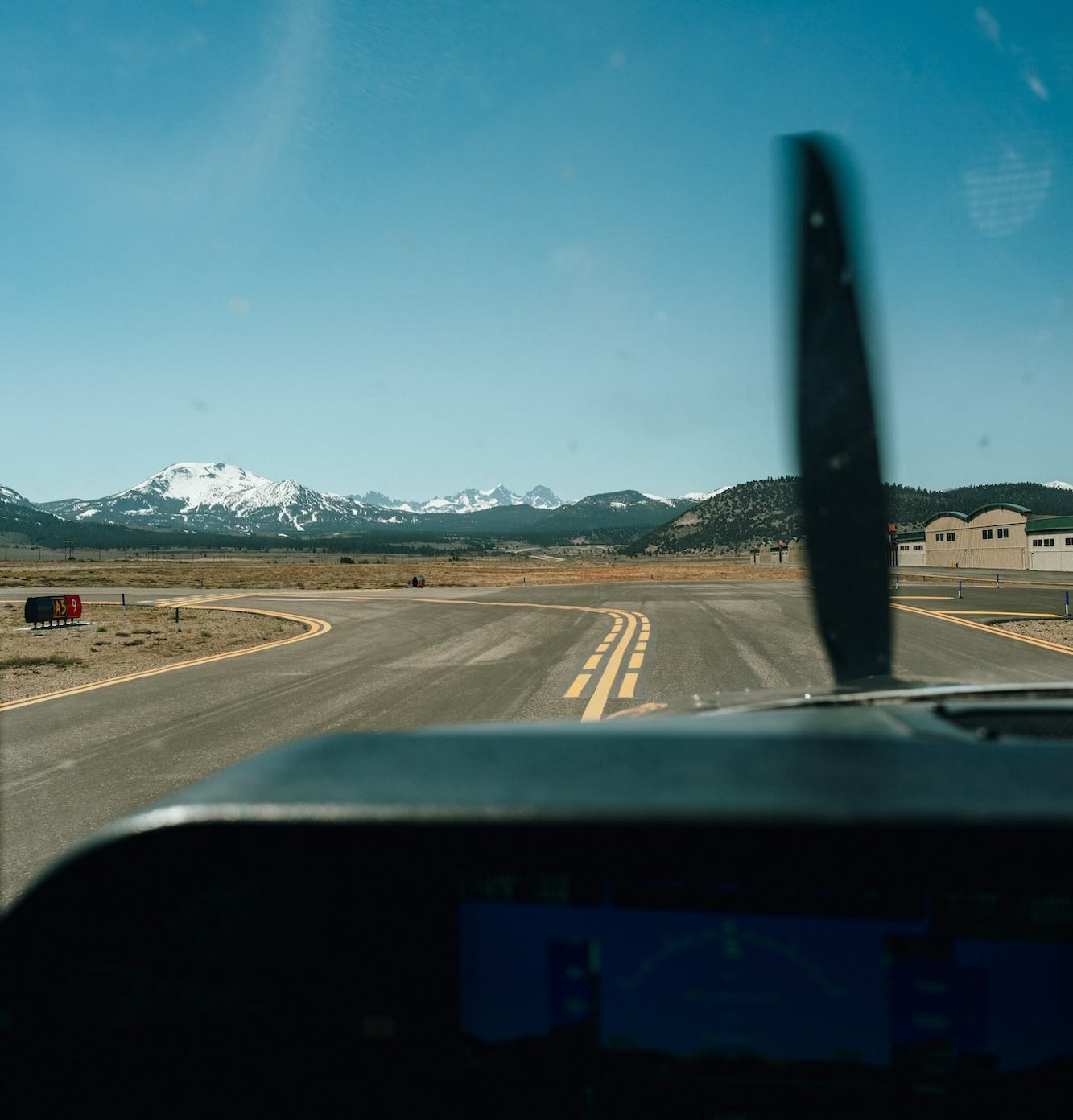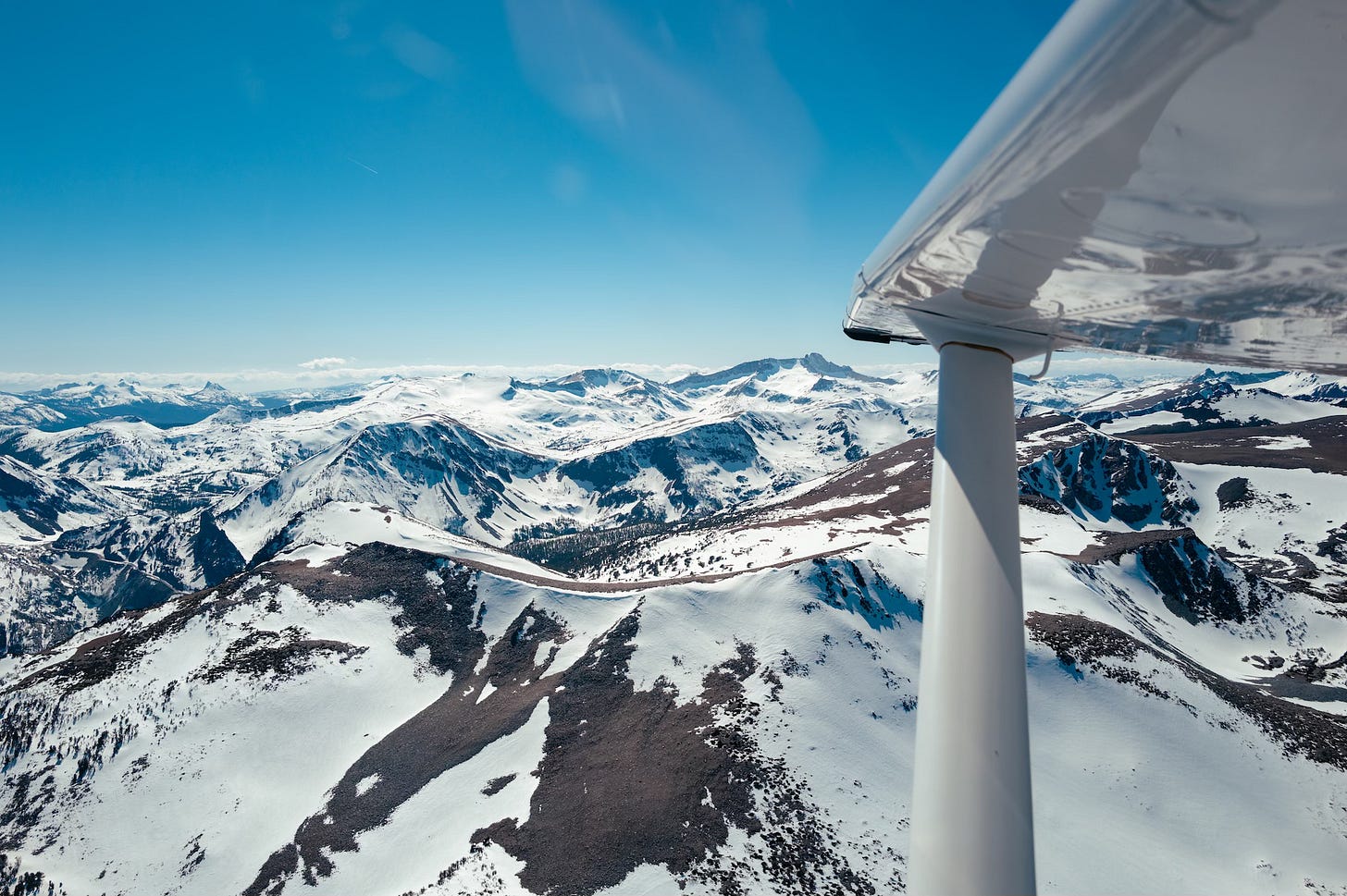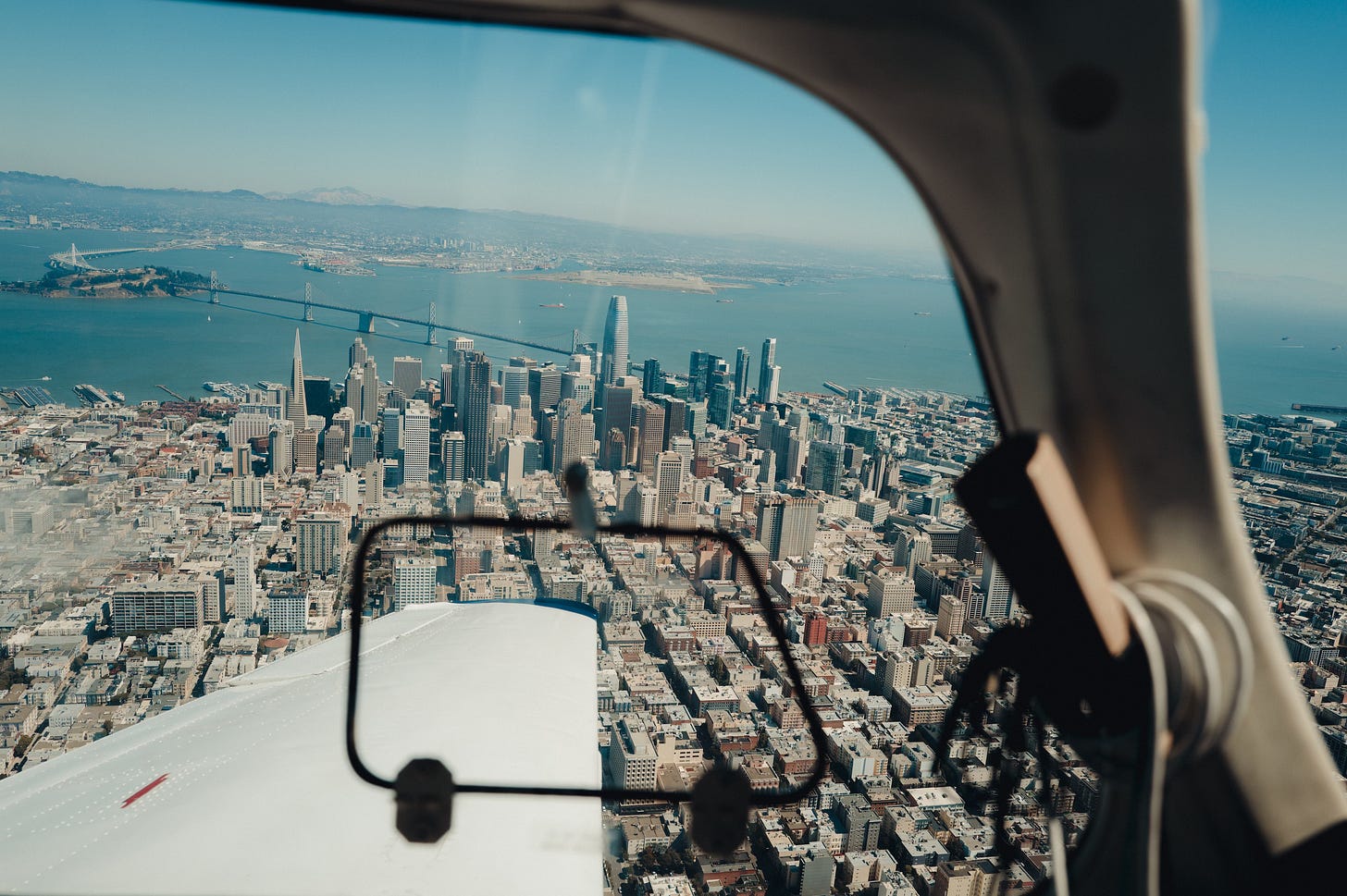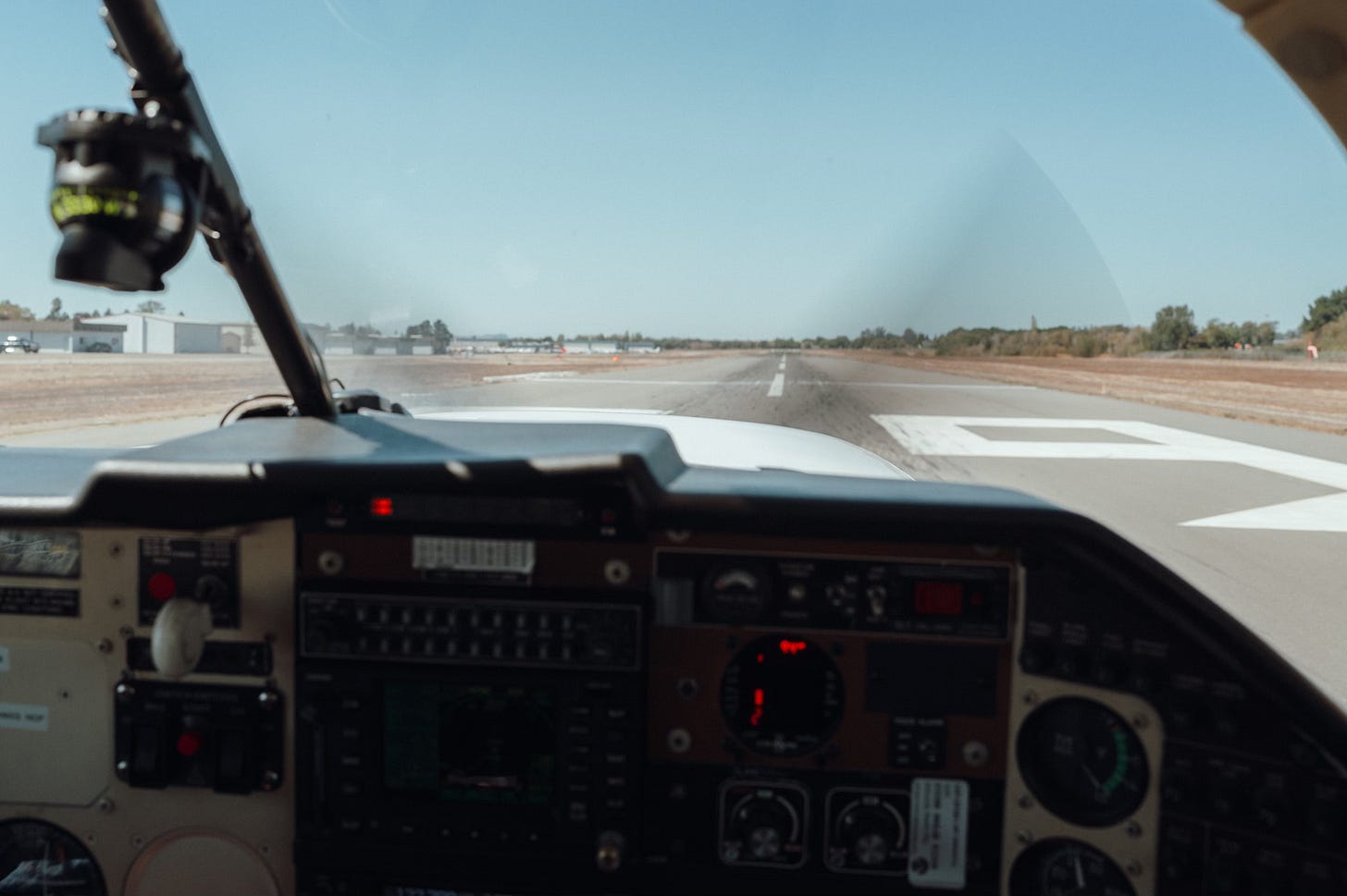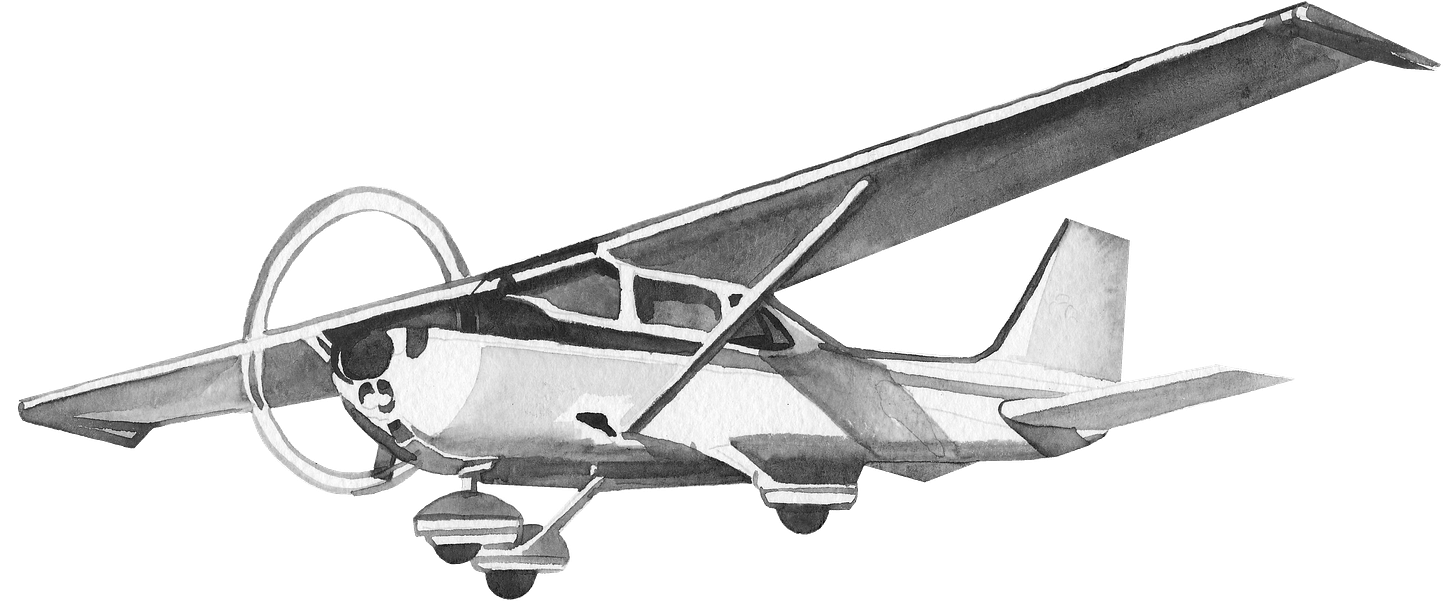The Flying Canon
On the finest books about airplanes, flying airplanes, and people who fly airplanes
Aviation has a rich literary tradition. It is, after all, intoxicating to be up there. I suppose a lot of pilots cannot help but try to express it in words.
There is also the fact that incapacity can turn harmony between man and machine into something unforgiving. Experience is a wonderful teacher, but it gives the test first and the lesson afterwards. So pilots through the generations take the trouble to write down hard-won wisdom.
What follows is a collection of aviation books. It’s what I wished existed when I was learning to fly, an “anti-library1”; a place to find inspiration and a place to find the thing you are looking for when you need it.
I thank Oliver Coolidge, Brandon Essex, Jim Hopp, Tom Church, Lou Dietz, Alan Marcum, Nick Pliam, Matthew Schulz, Debashish Sinha, Nick Steel, and Glen White for their contributions.
Basics & Aerodynamics
Stick and Rudder is the classic “first flying book” for a reason and should be the first stop to understand the fundamentals of flying light aircraft, which have not changed since it was written in 1944. I like The Student Pilot's Flight Manual as a general account for new or aspiring pilots.
Understanding the aerodynamic window of an airplane (and staying in it) would prevent many common accident scenarios. See How it Flies by John S. Denker is not a published book but an online publication of sorts, and the single best treatment I have seen of aerodynamics for private pilots. I highlighted it thoroughly as part of my training and revisit it often. More arcane is Aerodynamics for Naval Aviators, a classic for good reason but best saved as extra credit. It’s dense. On what can happen if you do not stay in the envelope there is Stalls, Spins, and Safety by Sammy Mason.
The FAA publications: the Pilot's Handbook of Aeronautical Knowledge, and the Airplane Flying Handbook, are really quite good. I liked them more as ways to cement and reference knowledge than as introductions.
Airmanship
Every new pilot will some day have the transcendent experience of flying with someone who is a Pro. I do not mean someone who flies professionally for a living, though such pilots may also be Pros, but someone who demonstrates a union — of composure, confidence, proficiency, knowledge, discipline, decision making, preparation, humility — that you forever strive for2.
Tony Kern’s Redefining Airmanship gives you a set of principles to aspire to in your flying and is excellent. His older book Flight Discipline covers some of the same ground. Kern’s methodology is grounded in the idea of going pro; even a flight around the pattern must be a disciplined practice.
I love the spirit of Artful Flying by Michael Maya Charles, more Eastern philosophy than Tony Kern’s work, but speaking of the same thing. There is also The Art of Clear Thinking by F-35 pilot Hasard Lee.
At some point in training, a student pilot will ask their instructor a question, hoping to have a decision made for them. If they are lucky, their instructor will say: I don’t know, you tell me, you are the pilot in command. Paul Craig explores the idea in depth in Pilot in Command.
Stories & Histories
There is something poetic to being aloft. The obvious starting point is Antoine de Saint-Exupéry; Wind, Sand, and Stars is my favorite, a lyrical reflection on the danger, romance, and camaraderie of flying air mail in the early 20th century. My copy has more passages highlighted than not. He has also written Night Flight and Flight to Arras.
Another poet-pilot is Richard Bach, best known for his bestseller Jonathan Livingston Seagull, whose triad of aviation books reveal a gifted writer totally obsessed with airplanes. The three books, in publication order, are Stranger to the Ground, Biplane, and Nothing by Chance. They are wonderful.
Ernest K. Gann’s Fate is the Hunter is a beautiful memoir, the treacherous and heady early days of commercial flying transitioning to the darkness and desperation of wartime flying. Gann is an excellent storyteller. (Also see The High and The Mighty). For a modern contrast, try Skyfaring, by a British Airways 747 captain who revels in the emotional delight of flying.
West with the Night is the classic memoir of bush pilot Beryl Markham in 1940s Africa. Hemingway said she wrote so marvelously well that he was ashamed of himself as a writer.
Flight of Passage is a story of two young brothers, 15 and 17, who fly across America in a little Piper Cub in the summer of 1966. Lots of what the boys experience is absent from the world today, in a way that will give you pause. In this vein there is also The Cannibal Queen by Stephen Coonts, the recounting of a father-son duo flying a 1942 Stearman across the United States. If you are inspired to buy an old Skylane and do something similar, you might turn to Week-End Pilot by Frank Kingston Smith.
From the pros there is Forever Flying by Bob Hoover, a wonderful reflection on fifty years of aerial adventures. Another rich flying life is recounted in North Star Over My Shoulder, by Robert Buck.
Aloft contains some wonderful essays on the aerial perspective, of how flying has altered the world and how we see our place in it. Free Flight is a thought provoking re-imagination of personal air travel imbued with infectious enthusiasm for recreational flight, written by a journalist and writer who has spent considerable time flying around small towns in the US with his wife in their Cirrus, a company chronicled extensively in the book.
Wager with the Wind tells the story of Don Sheldon, among the best of the Alaskan backcountry pilots. See, too, Flying the Alaska Wild, a bush pilot’s recollection of everything the Last Frontier can throw at you.
David McCullough, who has profiled figures from Truman to Roosevelt to the Panama Canal, also turned his attention to The Wright Brothers; the story of two bicycle mechanics who altered history.
Wartime
Many flying stories are wartime stories. There is First Light, the story of Geoff Wellum, a seventeen-year old thrown into occupied France as a young Spitfire pilot for the RAF. Considered by many to be the finest aerial account of this era is The Big Show, Pierre Closterman’s masterfully told story of being on the other side.
Chickenhawk is the electrifying story of the helicopter war in Vietnam. Combining stories from WWII and Vietnam is Robin Olds, an ace US Fighter Pilot. And going back to the beginning of large scale aerial warfare there is Sagittarius Rising, a singular memoir about flying taildraggers in the Great War.
Wartime is also a story of large scale coordination. There is The Candy Bombers, the story of supply aircraft touching down at Tempelhof every 45 seconds to keep a city alive during the Berlin Airlift. Vulcan 607 covers the story of the then longest-range aerial bombing mission, the opening salvo of Falklands war. Skies of Thunder is the tale of Allied forces learning to brave the fearsome mountain barrier of the Himalayas in WWII to haul supplies from India to China — with a casualty rate higher than some combat units.
More humanity and less logistics is A Higher Call, a near unbelievable story of brotherhood between enemies over wartime Germany. The same author has also written Devotion, the story of one pilot’s rescue mission to save a friend.
Lastly there is the classic Sled Driver, authored by an SR-71 pilot and devilishly hard to find for a reasonable price. It pairs excellently with Skunkworks, a look at Lockheed’s famed division of that name. Its former boss chronicles the development of the SR-71, the U2, and the first stealth fighter. Along these lines there is Always Another Dawn, the story of one of the first test pilots for rocket-powered aircraft.
Weather
Pilots have access to many sources of weather information and must learn the meaning and signs of the air around them. It may be a matter of life and death.
The best and most up-to-date single volume treatment on the subject is Pilot Weather, which helps with a fundamental understanding of weather as well as consuming various weather products. Also excellent is Understanding the Sky by Dennis Pagen, originally a weather book for glider & hang glider pilots and updated to be of broader interest. It is a valuable introduction to learning to “see” weather.
The canonical practical classic is Weather Flying by Robert Buck. It is dated in some ways but the fundamentals have not changed. From the FAA, there is the Aviation Weather Handbook, an update to an older advisory circular and great reference material.
For anyone flying in or near mountains, I commend Exploring the Monster. After WWII, military aircraft were still being lost in mysterious turbulence on the lee side of the Sierra Nevada. Pilots in the Owens Valley spoke of “the Sierra Wave” — smooth, soaring up-currents above a band of brutally rough air. Some thought instruments were malfunctioning. The Air Force funded an experiment to find out what was really going on, and this book documents what was learned.
Flying in the Real World
Much of primary flight instruction is about the fundamentals, but there are other lessons that come with time and translate theory to practice. How do you find parking at an unfamiliar airfield? Should you land with full flaps in a crosswind? How do you really know if the wake turbulence from that Airbus will affect you?
The Proficient Pilot, Volume 1, Volume 2 and Volume 3 are a compilation of instructor Barry Schiff’s monthly AOPA columns with excellent practical advice for pilots. There is also a version that contains much of the same material in multiple choice format, called Test Pilot.
Another trilogy; the Thinking Pilot's Flight Manual Volume 1, Volume 2, and Volume 3 are the book versions of a series of columns by instructor Rick Durden (originally published on AVWeb) that contain invaluable lessons if you can ignore a slightly convoluted narrative structure.
Flight Times is the memoir of a lifetime aviation educator who cannot help but use most of his memoir to teach.
There is also Tips To Fly By, by Richard Collins, which is exactly what it sounds like. And the Professional Aviator's Notebook is a five volume set that encapsulates lessons learned from a lifetime of aviation, the first three of which are available now.
As an aside, there are also some high-quality podcasts3 and magazine columns4 in this category, as well as some quality resources from organizations like Pilot-Workshops that do an excellent job of video-based scenario and real world instruction.
Finally, I suggest looking for books on topics you are occupied with. For instance, if your landings could stand to advance in quality, there is Make Better Landings. It made me feel I could go grease some beautiful crosswind landings. (I could not, but it’s a good book).
Communications
Clear and efficient radio communication is the backbone of the airspace system.
Say Again, Please is the classic guide, and I learned a lot from it. The VFR Communications and IFR Communications manuals from Pilot-Workshops are also recommended often.
A note on other methods, as strong radio work can require some practice. The Plane English app simulates various VFR and IFR communication scenarios so you can practice them on the ground. And Pilot Edge, a virtual air traffic control network staffed by real controllers, can be used in conjunction with a flight simulator to work on communications in “real world” scenarios5.
Safety
Matters of safety most people fret about (catastrophic engine failure, the wings choosing to detach from the rest of the aircraft, and so on) are rare events, but pilots keep stubbornly crashing for avoidable reasons (flying into weather conditions they cannot handle or running out of fuel)6. If you are interested in the statistics, I like this analysis from Phillip Greenspun.
One reaction to learning that ~80%+ of general aviation incidents were due to pilot error may be to think that you would not be so careless. But it’s one thing to think you’d never fly into marginal conditions or take to the air if something sounded off, and another to make the hard call when you’re at an airfield a five hour drive from home with an impatient passenger.
Two books are oft-recommended in this category: The Killing Zone is based on somewhat flawed statistical methodology, but is very valuable nonetheless. The other is The Next Hour, by Richard Collins, a more general account.
On the human side there is Human Factors in Flight, by Frank Hawkins, a longtime KLM captain who contributed much to the study and awareness of human psychology on aviation safety. There is also Why Planes Crash, an accident investigator’s lessons from a career dedicated to making aviation safer.
Systems
The reference manual to better understand aircraft systems holistically is Aircraft Systems for Pilots.
On engines and maintenance, the standard is the work of Mike Busch, a long-time A&P who has done incredible work to evolve approaches to GA maintenance. Manifesto is the short and sweet starting point; Engines is the next step. Aircraft Ownership Volume 1 and Volume 2 have important information for current and prospective owners but also anyone who cares about taking care of the aircraft they fly. There is also the Sky Ranch Engine Manual.
Avionics vary by aircraft, so I’ll stick to the Garmin G1000 as an example. Similar resources exist for many other avionics stacks. I really like Max Trescott’s comprehensive G1000 and Perspective book. There is also The Garmin G1000W: A Pilot Friendly Manual from Pilot-Workshops and I especially benefited from the various exercises in The G1000 Exercise Book.
Specialized Flying
A common refrain I hear from pilots who pursue their instrument rating is some version of: I didn’t realize it before, but I was only half a pilot. Well-regarded introductions: The Pilot’s Manual: Instrument Flying and Rod Machado’s Instrument Pilot Handbook. I used the latter for instrument training and liked it. The FAA publications are the Instrument Flying Handbook and the Instrument Procedures Handbook. An oft-recommended classic is Instrument Flying by Richard Taylor, though it is fundamentally about a pre-GPS world and thus is beginning to show its age.
On flying in mountains and rugged terrain, the, uh, bible, is Mountain Flying Bible by Sparky Imeson; containing not just plentiful notes on mountain flying but lots of good aviation sense. I recommend it highly. There is also the classic Bush Flying: Concepts and Techniques for the Pro by F.E. Pots. More technical and also suited to backcountry adventures is Mountain, Canyon, and Backcountry Flying.
The Compleat Taildragger Pilot is the gold standard for anyone who wishes they could see less of the taxiway. There is also Notes on the Tailwheel Checkout.
There is plenty missing here: seaplane ratings, multi-engine, aerobatics, or perhaps a jet type rating. Not to mention those flying machines that don’t have wings. Excellent books, I’m sure, exist in each of these domains.
This essay was prompted by a conversation with a friend who was thinking about taking a mountain flying course. I recommended a book, and he made a comment about wanting to grow his “aviation library” but not having gotten around to doing so. I hope this makes it easier.
If you’d like to suggest an addition or correction, do reach out.
The air up there in the clouds is very pure and fine, bracing and delicious. And why shouldn’t it be? – it is the same the angels breathe.
A term that came from the Italian writer Umberto Eco’s response to having 50,000 books in his private library:
“It is foolish to think that you have to read all the books you buy, as it is foolish to criticize those who buy more books than they will ever be able to read. It would be like saying that you should use all the cutlery or glasses or screwdrivers or drill bits you bought before buying new ones. There are things in life that we need to always have plenty of supplies, even if we will only use a small portion. If, for example, we consider books as medicine, we understand that it is good to have many at home rather than a few: when you want to feel better, then you go to the 'medicine closet' and choose a book. Not a random one, but the right book for that moment.”
The website Inner Art of Airmanship, particularly the “How It Started” post, is a good example of what I’m talking about.
There is AOPA’s There I Was… Podcast and Flying Magazine’s I Learned About Flying From That among others.
From EAA’s Sport Aviation, there is Steve Krog’s The Classic Instructor, Charlie Precourt’s Flight Test, and Robert Rossier’s Stick & Rudder. From AOPA Pilot, there is Catherine Cavagnaro’s Flying Smart and Natalie Bingham Hoover’s Flying Life. On AVWeb, there is John Deakin’s excellent Pelican’s Perch, my personal favorite, sadly no longer a regular feature but with an excellent back catalogue.
There is also VATSIM, but that network is more geared toward hobbyist flight simmers. A good explanation on the differences, albeit a necessarily biased one, can be found here on the Pilot Edge website.
Read the McSpadden Report (formerly the Nall Report) from AOPA for the latest numbers.
